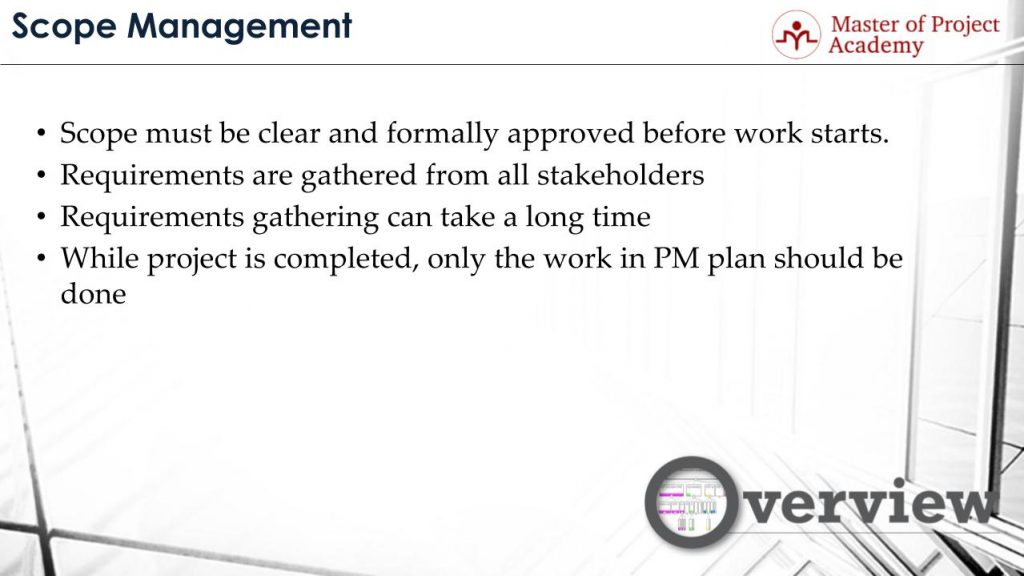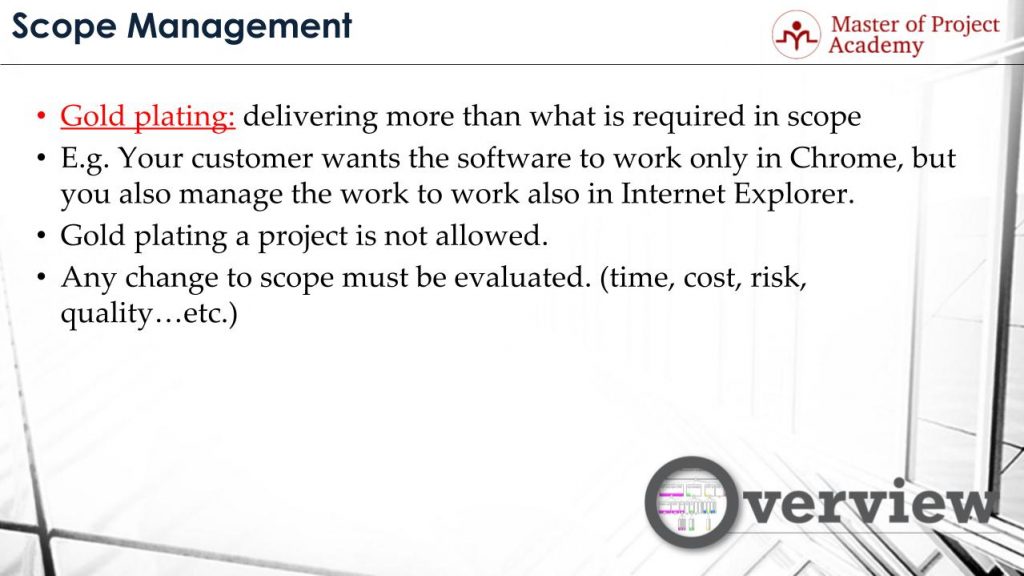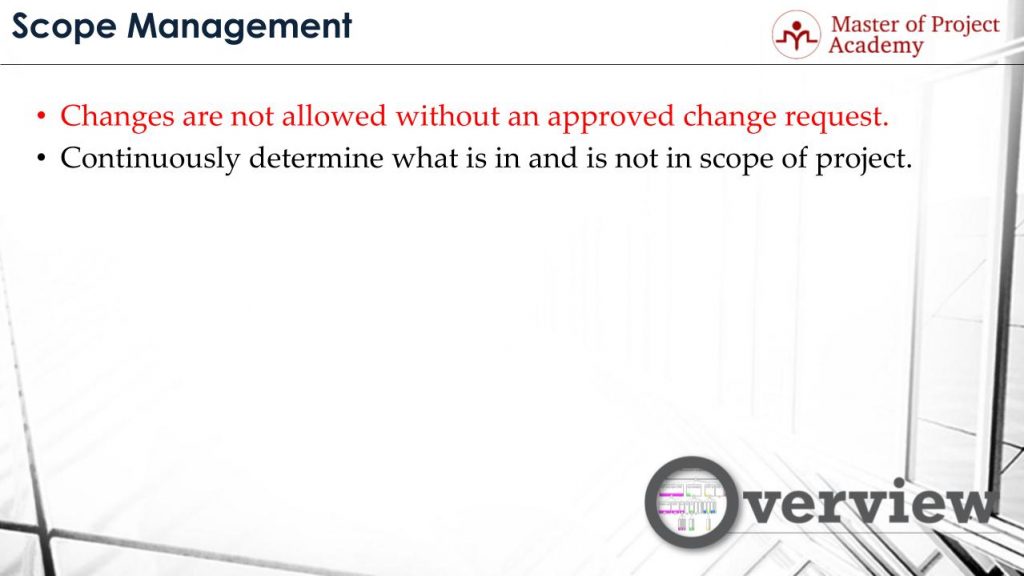Scope management is the second project management knowledge area, after project integration management. It holds a very crucial position during the project life cycle. If you want to learn more about scope management, a good quality PMP certification training will guide you through this knowledge area.
Attend our 100% Online & Self-Paced One-Hour Free PMP Training.
What is Scope Management?
PMI certification training describes Scope Management as “the process of defining what work is required”. Then, making sure that all of this work and only this work is done. The scope of a project defines what will be delivered throughout the project. Therefore, it directly constraints the schedule of a project, resource requirements, project budget etc. In order to complete a project successfully, scope management must be done appropriately and only the work in the scope must be delivered.

What are the Best Practices?
The scope must be clear and formally approved before work starts. During planning, several business and customer requirements are gathered from project stakeholders. These requirements actually constitute the base of the project scope. Some of these requirements will be conflicting each other. Or maybe some of the requirements will be eliminated after meetings. In the end, there will be a final project scope. Since it will describe what will be produced and delivered as the outcomes of the project, this final scope must be agreed by all project stakeholders.

Let’s consider that you are working on an e-commerce shopping website project. These requirements below may be the requirements from the stakeholders:
- A stakeholder from marketing department might require being able to send vouchers to members if they did not purchase anything in last 30 days,
- A product manager of the project might require the system to support up to 1 million members,
- A security operations stakeholder might require the website to be HTTPS compliant and secure for transactions.
These requirements actually constitute the scope of a project.
How to Gather Requirements?
In scope management, gathering requirements is an important duty, since the scope will depend on these. Requirements gathering can take a long time depending on the project, number of stakeholders and complexity of a project. Because you need to get expectations of stakeholders, evaluate conflicting requirements and maybe you will need to organize several meetings to finalize your requirements.

While the project is completed, only the work which is in the project management plan should be done. Because all your budget planning, schedule planning, resource planning, risk planning etc. has been done based on your agreed scope. If you try to deliver anything extra that is not in the scope, this will bring a risk to exceed your plans respectively.
What is Gold Plating?
Gold-Plating is delivering more than what is required in the scope. Once you initiated a project, there will be new requests coming from the customer. Most of the time, the customer will claim that what they are requesting is not a change request. As a project manager, you must be careful in project scope management and make sure that you will not be doing anything extra other than the agreed project scope. But in some cases, project team performs an extra activity and delivers extra work which is not in the scope of the project and this is called gold-plating.

For instance, let’s consider our e-commerce shopping website example. Your customer wants the system to work only in Chrome browser. But if you managed it to work in Internet Explorer, or in another browser too, this is an example of gold-plating. Because in your agreed scope, you must deliver a system that will work on Chrome but you did an extra work to deliver Internet Explorer operability as well.
Of course gold-plating a project is not allowed. But why? Because the extra work that you are will be doing will bring extra effort, extra budget necessity, extra resource requirements etc. Therefore, Project manager in a project must prevent gold-plating.
How to Evaluate Changes in Scope Management?
There might be change requests coming from the customer and any change to the scope must be evaluated before being accepted. In scope management, a change’s impacts on time, cost, risk planning, quality etc. must be assessed. For instance, making the e-commerce shopping website operable in Internet Explorer will bring extra development and test effort. Naturally, this will bring additional cost and risk with it respectively. These must be evaluated by the relevant stakeholders and change control board must accept the change before implementing it.

Changes are not allowed without an approved change request. After change evaluation, its impacts on schedule, cost, quality, resources etc. will be highlighted. If the change control board agrees to implement, then the change can be implemented.
How to Prevent Scope Creeps in Scope Management?
In order to prevent scope creep, the project manager must continuously determine what is in and what is not in the scope of the project. Because while you are managing a project, one of your project resources might be doing extra work. For instance, although it is not in your project scope, one of your software developers might be developing shopping cart function to work in Internet Explorer as well. And this may cause him to delay his activity and bring extra cost. During scope management, the Project Manager must be aware of the project scope and prevent any scope creeps that might occur throughout the project.

What are the Processes of Scope Management Knowledge Area?
There are six processes of scope management. Four of the processes are in Project Planning Process Group and two of them are in the project monitoring and controlling process group.
These processes of scope management are:
- Plan Scope Management Process,
- Collect Requirements Process,
- Define Scope Process,
- Create WBS Process,
- Validate Scope Process
- Control Scope Process
If you are an aspirant PMP, first you can enroll in a free PMP training before going into the details of project management knowledge areas such as scope management. And after gaining a general knowledge about what is PMP, you can learn the details of scope management and other knowledge areas and get ready for the PMP certification exam.
Review by: Edwin Coleman



10 thoughts on “Scope Management: Transforming The Requirements Into The Scope”
Comments are closed.